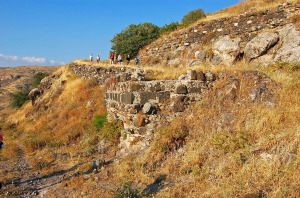Jesus delivered his famous sermon from the northwestern shore of the Sea of Galilee, near his base in Capernaum. At the time, Hippos was a bustling city atop a flat hill rising more than 1,000 feet above the water on the eastern shore of the lake, near today’s Kibbutz Ein Gev. In making his points, Jesus referred to salt and lamps, items his followers encountered every day. Most scholars believe Jesus had Hippos in mind when he told his listeners that “a city that is set on a hill cannot be hidden” because it was the only hilltop city they had seen.
Hippos was founded by the Greeks in about 200 B.C., its name reflecting the hill’s claimed resemblance to a horse. After a period under control of the Jewish Hasmoneans, in 63 B.C. the city came under the rule of the Romans, who made it one of the ten semi-autonomous Greco-Roman cities of the Decapolis. Recent excavations have revealed that life in first-century Hippos was much different from that in the Jewish fishing villages where Jesus taught. Archaeologists have uncovered a column-lined Roman main street running the 500-meter length of the hilltop, flanked by theaters, nude bath houses, temples to Zeus and Aphrodite, and a fountain dedicated to sensuous water nymphs, all gleaming in the afternoon sun when Jesus and his followers gazed across the lake.
A narrow path leads to the ruins of Hippos, with signs warning: “Mines on both sides of the trail; walk only on the marked path.” At the top of the hill are remains of several Byzantine-era churches, destroyed by an earthquake in 749 A.D. Hundreds of years after the Sermon on the Mount, Christian lights finally shone from the famous city on a hill.
